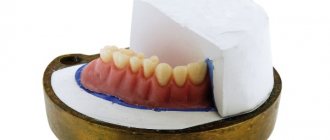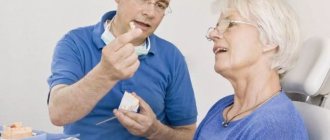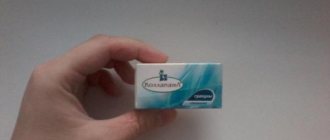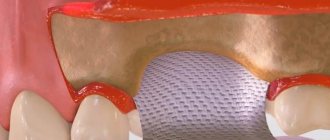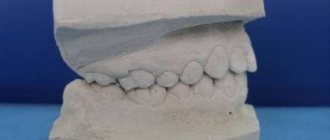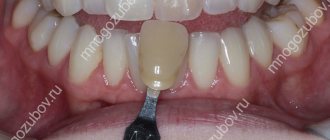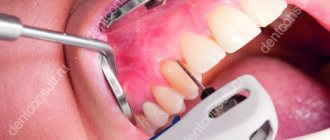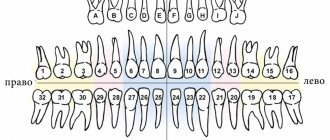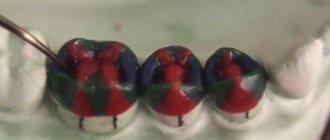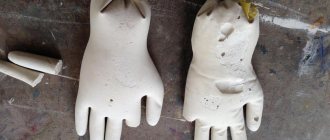9398
An impression or cast of teeth is necessary in the process of prosthetics of any elements of the dentition.
Also, orthodontics cannot do without the use of impressions when creating alignment or bite-correcting systems.
It is used to produce the most precise orthopedic and orthodontic devices.
general description
An impression is an impression of one or all elements of the dentition, according to which models of future designs for prosthetics are cast in laboratories.
The scope of application of impressions is orthopedic dentistry. When taking an impression, the specialist uses impression trays, as well as various types of materials - plaster, silicone, etc. Impressions are made before making corrective devices.
Casts are also used for aesthetic purposes, such as bleaching units. Silicone mouth guards are made based on tooth imprints, which are used to perform remineralization restoration of elements.
Using impressions, you can make a diagnostic model and determine the type of dental disease.
Pursued goals
An impression or cast of teeth is a reverse image of the dentition and the surface of the alveolar process using impression materials. The impression takes the form of a series of depressions in the impression mass or, if there are no teeth, a continuous depression formed by the toothless alveolar process.
Taking an impression is one of the main preparatory operations for orthodontic and orthopedic treatment.
The final goal is the production of diagnostic, working, control and auxiliary models that are necessary for orthodontic and prosthetic treatment.
For models made on the basis of prints:
- diagnose an anomaly , determine the nature, magnitude and direction of tooth displacement, type of bite, and take the necessary measurements;
- having installed the models in the occluder , they check the occlusion, the nature of the movement of the jaws, the coincidence or divergence of their central lines, and other characteristics of the dentofacial apparatus;
- choose a braces system that can correct diagnosed anomalies;
- develop a detailed treatment plan;
- if necessary, a 3D image of the jaw is developed by scanning a plaster model and transferring the data into a computer program (this may be necessary, in particular, for indirect fixation of braces on the teeth).
In general, the model is necessary to ensure high-quality and predictable treatment and avoid errors.
Are braces always installed for diastema and how effective are they?
Come here to view Occlufast impression material.
At this address https://orto-info.ru/ortodonticheskoe-lechenie/podgotovitelnyiy-period/taktika-planirovaniya.html we will talk about competently drawing up an orthodontic treatment plan.
Types of impressions
Impressions are divided into anatomical and functional. In the first case, the construction is manufactured without taking into account the characteristics of the tissues that are located on the border of removable dentures.
In the process of creating functional structures, medical instruments are used, selected in accordance with the individual characteristics of the patient.
Due to this, the mobility of the soft tissue folds located on the border of the implantation bed is reflected on the impression. A functional impression is indicated for patients who have lost all or part of their teeth.
Functional type products are classified into types:
- Compression. Used to take an impression of the lower jaw.
The products reflect the relief of the base of the prosthesis and allow you to redistribute the load during chewing over a larger area of its base. Due to this property, premature atrophy of bone structures is prevented. To make a compression print, materials with high viscosity values are used. - Unloading. The base of the prosthesis made from the unloading cast will have the shape of uncompressed mucous membranes.
This type of device is recommended for people whose professional activities involve speaking. The load during chewing will be distributed unevenly due to the mismatch between the relief of the bone tissue and the base of the prosthesis. - Combined. Necessary for creating devices that compress the pliable and unload the sedentary areas of the mucous membranes of the mouth located in the prosthesis area.
Thanks to differentiated impressions, implants are created that provide an even load during chewing or speaking.
Do-it-yourself prosthesis repair at home
The best way to repair a prosthesis is to contact a specialized laboratory technician. He will not only eliminate the defect, but also carry out preventive cleaning and correct the unbalanced basis. But situations arise when a visit to the dentist is simply impossible, so you can repair the structure at home.
The success of the procedure depends on the cause of the breakdown:
- poor quality and dentist errors;
- wear and tear of the material after the end of its service life ;
- abuse of crackers, nuts;
- gum subsidence.
At home, you can fix minor damage: a loose artificial molar, a chip on the base or a crack on the base. If deformation occurs due to subsidence of the gums, the appearance of a tumor or frequent inflammation, it is necessary to apply for a full correction of the prosthesis. Broken support pins and cemented crowns cannot be repaired with your own hands.
Features of pharmacy adhesive for dentures
You can repair a cracked removable denture using pharmaceutical glue (Coracryl and Protacryl-M). These are special formulations that have a number of advantages:
- do not provoke allergies;
- do not react with saliva and food;
- do not degrade the quality of the prosthesis;
- eliminate damage for a long time.
Read Tooth removal before prosthetics - disinfection, preparation for a crown
The product in two bottles can be purchased in special stores. They offer entire kits for urgent repair of denture structures. They contain varnishes and wax polymers that are safe for mucous membranes, which reliably and quickly glue the edges of the crack without deforming the base.
How to use it correctly?
To prepare the glue, you need to mix a little liquid from each bubble in a 2 to 1 ratio and place it carefully. The crack on the prosthesis is carefully rubbed and sanded to eliminate unevenness. Using a miniature spatula or syringe, apply a thick layer of glue to the defect. The polymer lamp speeds up the curing process. After complete drying, it is necessary to remove the tubercles and remove the seal, making sure there are no sharp corners.
Why can't you use ordinary industrial glue?
To repair artificial teeth with your own hands, you must use only high-quality materials. Conventional glue for working with plastic is attractive due to its low price and availability, but has a number of serious disadvantages:
- may corrode acrylic or nylon soft base;
- provokes deformation and curvature of the base;
- causes an allergic reaction;
- leaves a specific taste.
Household glue often contains dangerous toxic compounds. With saliva, they enter the esophageal mucosa and provoke inflammation of the stomach walls, corroding them. This can cause painful gastritis or ulcers.
Material groups
All materials used to make impressions are hypoallergenic.
The domestic industry offers 3 types of materials for creating impressions - hard, thermoplastic and elastic.
Solid
Gypsum is most often used to make the structure. It consists of a powder diluted with water and contains:
- calcium sulfate;
- borax;
- starch;
- hemihydrate
The hardening process of gypsum is easily controlled by introducing additional amounts of borax and calcium sulfate.
The material mixes easily, the main thing is not to trap air during the procedure. Otherwise, pores will form on the surface of the material.
The hardening time of the plaster impression is 2-3 minutes. The mixture is characterized by low viscosity and good spreading over the surface of mucous membranes.
Among the advantages of gypsum it should be noted:
- reproduction of the relief of soft tissues with high accuracy;
- ease of use;
- maintaining original dimensions;
- possibility of delayed production of a plaster model.
The disadvantages of the material include:
- increased rigidity;
- the impossibility of creating an imprint from those parts of the tooth that are located close to the surface of the gums (undercuts);
- Patients have a feeling of dry mouth after removal of the impression.
Among the hard materials used to create an impression, dentol should also be noted. The material is a mixture of guaiacol and zinc oxide eugenol.
Advantages of Dentol:
- low degree of shrinkage and deformation;
- the ability to create accurate impressions of the surface of teeth and soft tissues;
- possibility of long-term storage;
- harmlessness.
Is it always necessary to file teeth before installing braces?
Learn more here about how braces work.
At this address https://orto-info.ru/ortodonticheskoe-lechenie/podgotovitelnyiy-period/separatsiya-zubov.html we will tell you what teeth separation is.
Elastic
Elastic impressions are divided into 3 groups - silicone, alginate and thiokol. The basis of these materials is agar.
To ensure product strength, fillers are added to the impression mass. When heated, materials become soft, and when cooled, they become elastic.
Analginate products include novalgin and stomalgin. The design is characterized by a high degree of elasticity and a clear recreation of the contours of the prosthetic bed.
In dentistry, prostheses for jaws with partial absence of teeth are made from this material. This type of cast is characterized by a significant degree of shrinkage, so they are not suitable for long-term storage.
Sodium alginate, which is part of the material, allows you to easily separate the impression from the prepared model.
Silicone materials are made from liquid polymers mixed with a hardener. Silicone is used in the manufacture of:
- porcelain crowns;
- metal-ceramic and bulge prostheses.
Silicone impressions shrink on average 3 hours after production. Therefore, the creation of models occurs no later than this time.
Thiokol prints in dentistry are used for the same purposes as silicone prints. The advantages of these products include a low degree of shrinkage, and the disadvantages include the difficulty of obtaining the required shape.
Thermoplastic
Thermoplastic impressions are produced in the form of disks with a diameter of 100 mm. The material begins to melt at a temperature of 50-70 degrees.
Thermoplastic products include gutta-percha and wall. Among the negative properties of thermoplastic, the following should be highlighted:
- difficulty in making models;
- lack of “delay”.
There are 3 types of thermoplastic masses:
- No. 1 – used to take impressions of jaws that do not have teeth;
- No. 2 – used in orthopedics to take maxillofacial impressions;
- No. 3 – used for the production of pin teeth and splints.
Advantages of thermoplastic:
- separates well from models made from them;
- amenable to metallization;
- can be repeatedly introduced into the patient’s oral cavity;
- suitable for performing functional tests.
Modeling
Modeling materials include various types of wax - casting, base and for inlays. In dentistry, modeling impressions are used in the process of creating metal prostheses.
Inlay materials are used to create locking fastenings in combined type prostheses.
Casting wax is used in the production of thin dentures, and base wax is used for modeling temporary bridge models.
The advantage of the materials is a clear display of the contours of teeth and soft tissues. Lack of wax means a high risk of deformation.
More details about the materials and devices used are described in the video.
Determining the color of a dental crown.
This stage is of great importance for the aesthetics of the future crown ; for obvious reasons, it acquires particular importance when restoring anterior teeth. Often, working with color is limited only to viewing a standard color scale with the patient and choosing the most suitable shade. This is better than nothing, but still too little for the dental technician to create an objective visual picture. Therefore, more and more often, doctors who take aesthetics seriously are resorting to professional photographic equipment. Only photographing from different angles can give the technician maximum objective information about the basic tone of the tooth, areas of pronounced transparency, the texture of the surface of natural teeth, the presence of any natural flaws (cracks, stains, stripes, etc.)
Photographs of teeth from different angles, incl. and with standard colors (pictured on the right) allow the dental technician to see all the smallest nuances of the structure of the patient’s natural teeth. With the proper manual skills and artistic skills, this allows you to create crowns that do not differ from your own teeth even in the smallest detail...
Basic requirements for products
In dentistry, there are a number of requirements for impressions:
- products must accurately follow the contours of the soft tissues that will come into contact with the prostheses;
- when removed from the oral cavity, the print should not be deformed;
- during storage, the impression should not shrink significantly;
- materials used to create the product must be disinfected without loss of quality;
- The print must be freely separated from the model made from it.
Oral preparation
The specialist begins creating an impression immediately after selecting suitable material and medical instruments. Before making an imprint, the bony organs of the oral cavity are dissected.
After this, the mouth is thoroughly dried with cotton swabs or a dental gun. Then the doctor kneads the materials he has chosen.
With complete adhesion, which is often observed in older people, the bone structures of the jaw undergo some changes.
In places where elements are missing, growths - exostoses - can form. The impression is taken after surgical removal of all bone growths.
Indications for correcting defects using orthognathic surgery and patient reviews about the effectiveness of the radical method.
In this article we will find out whether it is possible to put braces on crowns.
Here https://orto-info.ru/sistemyi-vyiravnivaniya-zubov/breketyi/kak-mozhno-tselovatsya-otkrovenno-o-sokrovennom.html read whether braces interfere with kissing.
Removal methods
The doctor selects the spoons with which the impression will be made, focusing on the shape of the patient’s jaws.
Orthopedists have a standard set of spoons in their arsenal, differing in size. Using fitting, the required tool number is determined.
Taking an impression is usually performed in several stages:
- First, a thick paste is applied to a tray lubricated with an adhesive substance and an impression is taken. Manipulations are performed before preparing the elements in order to leave room for the corrective composition.
- After tooth preparation, the gum pockets of the supporting elements are expanded. Retraction threads, pre-impregnated with vasoconstrictor compounds, are inserted into these grooves.
- To stop bleeding from the periodontal pockets and fix the retraction threads, a cotton cylinder is placed into the prepared element.
- The patient closes the teeth to ensure the gum pocket is dry.
The first layer of the print is shaped like the spoon with which it was made.
A layer of paste located on the top of the palate and along the edges is removed from the cast. This ensures free insertion of the impression into the oral cavity.
Intergingival partitions are also eliminated to eliminate the risk of squeezing the papillae located between the teeth.
The first layer of the product is thoroughly dried and filled with clarifying compounds. The impression is again filled with corrective pastes and left until completely dry. After this, the product is removed from the patient’s mouth.
There is another method for obtaining a dental imprint:
- First, the specialist fills the dental tray with the basic composition, and then with the corrective one.
- The correction paste is applied to the prepared units using a syringe.
- A dental tray with two types of pastes is inserted into the oral cavity to obtain an impression.
For one-step impression taking, silicone masses are used. Despite minor deformation and shrinkage, the resulting prints must be used within several hours.
The video shows the process of taking dental impressions.
How to make an impression of the jaw during dental implantation
It is important to properly plan the design of the future prosthesis in advance to ensure a good aesthetic appearance of the oral cavity. For this purpose, a cast of the jaw is taken in order to accurately reproduce all the details on the future model. It is easier to do this with installed implants than with already fixed abutments, but in both cases the basic principles of the technology are the same. The process uses an individual or standard spoon.
The main algorithm of actions is as follows:
- Using a fixing screw, transfers are attached to the implants or abutments (needed for precise fixation into the plaster impression).
- An impression mass (usually silicone or polyester) is applied around it.
- A tray filled with impression material is placed on top so that the tips of the screws appear from the holes, which are used to fix the implant analogue to the transfer when casting the model.
- After hardening, the impression is removed together with the fixing structure.
If access to the implants is difficult, the screws are unscrewed. The transfers do not need to be removed; they will only be removed to create an impression in order to be fixed in the appropriate area. While the permanent prosthesis is being manufactured, a temporary abutment is installed on the implant.
Price
The price of a print depends on the following factors:
- Features of the pathology. For example, in edentulous cases, individual dental trays are required to make impressions. This increases the cost of the procedure.
- Type of material. Typically, specialists do not use expensive raw materials when cheaper materials, for example, alginate, can be used.
On average, casting a plaster model will cost patients 300 rubles, and making an alginate impression costs the same. A silicone impression will cost more – from 550 rubles.
